Please email me at:
Or use the form below.
[contact-form 1 “Contact form 1”]
The no-pants guide to spending, saving, and thriving in the real world.
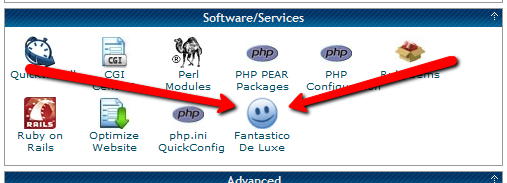
In this installment of the Make Extra Money series, I’m going to show you how to set up a WordPress site. I’m going to show you exactly what settings, plugins, and themes I use. I’m not going to get into writing posts today. That will be next time.
I use WordPress because it makes it easy to develop good-looking sites quickly. You don’t have to know html or any programming. I will be walking through the exact process using Hostgator, but most hosting plans use CPanel, so the instructions will be close. If not, just follow WordPress’s 5 minute installation guide.
Assuming you can follow along with me, log in to your hosting account and find the section of your control panel labeled “Software/Service”. Click “Fantastico De Luxe”.

On the Fantastico screen, click WordPress, then “New Installation”.
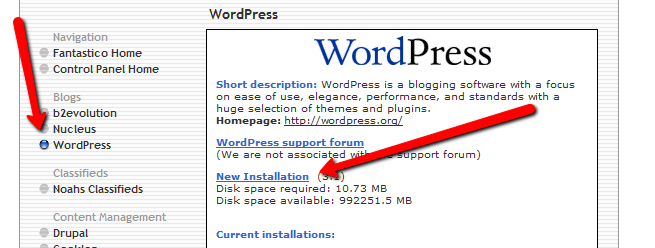
On the next screen, select your domain name, then enter all of the details: admin username, password, site name, and site description. If you’ll remember, I bought the domain http://www.masterweddingplanning.net. I chose the site name of “Master Wedding Planning” and a description of “Everything You Need to Know to Plan Your Wedding”.
Click “install”, then “finish installation”. The final screen will contain a link to the admin page, in this case, masterweddingplanning.net/wp-admin. Go there and log in.
After you log in, if there is a message at the top of the screen telling you to update, do so. Keeping your site updated is the best way to avoid getting hacked. Click “Please update now” then “Update automatically”. Don’t worry about backing up, yet. We haven’t done anything worth saving.
Next, click “Settings” on the left. Under General Settings, put the www in the WordPress and site URLs. Click save, then log back in.
Click Posts, then Categories. Under “Add New Category”, create one called “Misc” and click save.
Click Appearance. This brings you to the themes page. Click “Install Themes” and search for one you like. I normally use Headway, but before I bought that, I used SimpleX almost exclusively. Your goal is to have a simple theme that’s easy to maintain and easy to read. Bells and whistles are a distraction.
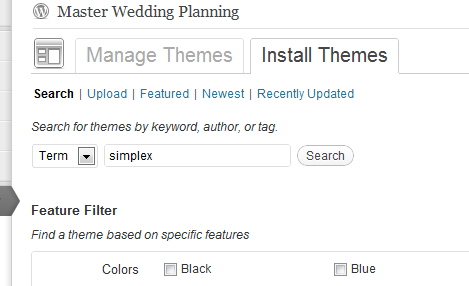
Click “Install”, “Install now”, and “Activate”. You now have a very basic WordPress site.
A plugin is an independent piece of software to make independent bits of WordPress magic happen. To install the perfect set of plugins, click Plugins on the left. Delete “Hello Dolly”, then click “Add new”.
In the search box, enter “plugin central” and click “Search plugins”. Plugin Central should be the first plugin in the list, so click “install”, then “ok”, then “activate plugin”. Congratulations, you’ve just installed your first plugin.
Now, on the left, you’ll see “Plugin Central” under Plugins. Click it. In the Easy Plugin Installation box, copy and paste the following:
All in One SEO Pack Contact Form 7 WordPress Database Backup SEO SearchTerms Tagging 2 WP Super Cache Conditional CAPTCHA for WordPress date exclusion seo WP Policies Pretty Link Lite google xml sitemaps Jetpack by WordPress.com
Click “install”.
On the left, click “Installed Plugins”. On the next screen, click the box next to “Plugins”, then select “Activate” from the dropdown and click apply.
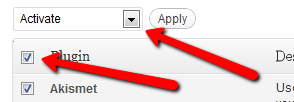
Still under Plugins, click “Akismet Configuration”. Enter your API key and hit “update options”. You probably don’t have one, so click “get your key”.
The only tool I worry about is the backup. It’s super-easy to set up. Click “Tools”, then “Backup”. 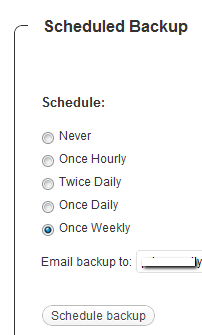
Scroll down to “Schedule Backups”, select weekly, make sure it’s set to a good email address and click “Schedule Backup”. I only save weekly because we won’t be adding daily content. Weekly is safe enough, without filling up your email inbox.
There are a lot of settings we’re going to set. This is going to make the site more usable and help the search engines find your site. We’re going to go right down the list. If you see a section that I don’t mention, it’s because the defaults are good enough.
Set the Default Post Category to “Misc”.
Visit this page and copy the entire list into “Update Service” box. This will make the site ping a few dozen services every time you publish a post. It’s a fast way to get each post indexed by Google.
Click “Save Changes”.
Uncheck everything under “Email me whenever…” and hit save. This lets people submit comments, without actually posting the comments or emailing me when they do so. Every once in a while, I go manually approve the comments, but I don’t make it a priority.
Select “Custom structure” and enter this: /%postname%/
Click save.
Set the status to “Enabled”, then fill out the site title and description. Keep the description to about 160 characters. This is what builds the blurb that shows up by the link when you site shows up in Google’s results.
Check the boxes for “Use categories for META keywords” and “Use noindex for tag archives”.
Click “Update Options”.
Check the boxes to remove each of the dates and set the alt text to “purpose” or something. This will suppress the date so your posts won’t look obsolete.
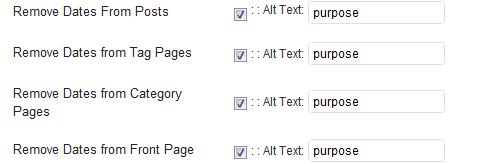
This plugin reinforces the searches that bring people to your site. It’s kind of neat. Skip the registration, accept the defaults and hit save.
Scroll to the bottom and click import. We’ll come back to this.
Select “Caching On” and hit save.
Across the top of the screen should be a giant banner telling you to connect to WordPress.com and set up Jetpack. You’ll need an account on WordPress.com, so go there and set one up. After authorizing the site, you’ll be brought back to the Jetpack configuration screen. Click “Configure” under “WordPress.com Stats”. Take the defaults and hit save.
On the contact configuration page, copy the code in the top section. You’ll need this in a moment.
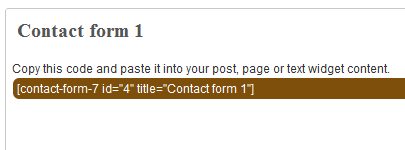
Now, we going to create a couple of static pages. On the left, click “Pages”, then “Add new”.
Name the first page “Contact” and put the contact form code in the body of the page. Hit publish.
Under Appearance, click “Menu”. Enter a menu name and hit save.
Then, under “Pages”, click the box next to “Contact”, “Disclaimer”, and any other policies you’d like to display. Hit save.
Also under Appearance, click “Widgets”. This is where you’ll select what will display in the sidebar. All you have to do is drag the boxes you want from the middle of the page to the widget bar on the right. I recommend Text, Search, Recent Posts, Popular Search Terms and Tag Cloud. In the text box, just put some placeholder text in it, like “Product will go here”. We’ll address this next time.
We’re not going to worry about getting posts in place, yet. That will be the next installment. However, the steps in the next installment could take 2 weeks to implement, and we want Google to start paying attention now. To make that happen, we need to get a little bit of content in place. This won’t be permanent content. It’s only there so Google has something to see when it comes crawling.
To get this temporary, yet legal content, I use eZineArticles. Just go search for something in your niche that doesn’t look too spammy.
Then, click “Posts”, then delete the “Hello World” post. Click “Add new”. Copy the eZine article, being sure to include the author box at the bottom, and hit publish.
To see your changes, you may have to go to Settings, then WP Cache and delete the cache so your site will refresh.
Congratulations! You now have a niche blog with content. It’s not ready to make you any money, yet, but it is ready for Google to start paying attention. In the next installment, I’ll show you how I get real unique content and set it up so Google keeps coming back to show me the love.
This weekend, my wife is off scrapbooking with my mother and sister-in-law. Instead of hanging around the house trying to keep three kids entertained, I’m at my brother’s house, since his wife abandoned him with their kids, too. I’ll let his kids keep mine entertained, and vice versa. Woo!
I am on the Slow Carb Diet. At the end of the month, I’ll see what the results were and decide if it’s worth continuing. For those who don’t know, the Slow Carb Diet involves cutting out potatoes, rice, flour, sugar, and dairy in all their forms. My meals consist of 40% proteins, 30% vegetables, and 30% legumes(beans or lentils). There is no calorie counting, just some specific rules, accompanied by a timed supplement regimen and some timed exercises to manipulate my metabolism. The supplements are NOT effedrin-based diet pills, or, in fact, uppers of any kind. There is also a weekly cheat day, to cut the impulse to cheat and to avoid letting my body go into famine mode.
I’m measuring two metrics, my weight and the total inches of my waist , hips, biceps, and thighs. Between the two, I should have an accurate assessment of my progress.
Weight: I have lost 30 pounds since January 2nd! That’s only 1 pounds since last week. 12 more to meet my goal for February. The difference this week? I’ve cut back on the supplements, to see if they actually make a difference. It would appear they do.
Total Inches: I have lost 16 inches in the same time frame, down 1.5 since last week.
I totally got live this joke.
Are you a compulsive shopper? Money Crashers has some tips to cut that down.
Before I got a smartphone, I relied on a PocketMod for almost everything a smartphone does. Does that make me a geek?
$39Glasses is having a killer sale. $15 off a $40 item is huge.
Tim Ferriss has a guide to slow-carb seasonings. It’s worth reading if your food is boring you.
This is where I review the posts I wrote a year ago. Did you miss them then?
This was Scam Week last year. I had a post on debt scams and scams that target disaster victims. As we roll into flooding season, it’s important to know how these scams work.
I also discussed my attempt to teach my son to savor delayed gratification. It has been working. He makes long-term(for an 11 year old) plans regularly.
Money Problems: Setting Goals was included in the Festival of Frugality.
Your Budget is Worthless was included in the Carnival of Personal Finance.
Brown Bagging Your Way to Savings was included in the Carnival of Money Stories.
Debt Burnout was included in the Totally Money Carnival.
Thank you! If I missed anyone, please let me know.
There are so many ways you can read and interact with this site.
You can subscribe by RSS and get the posts in your favorite news reader. I prefer Google Reader.
You can subscribe by email and get, not only the posts delivered to your inbox, but occasional giveaways and tidbits not available elsewhere.
You can ‘Like’ LRN on Facebook. Facebook gets more use than Google. It can’t hurt to see what you want where you want.
You can follow LRN on Twitter. This comes with some nearly-instant interaction.
You can send me an email, telling me what you liked, what you didn’t like, or what you’d like to see more(or less) of. I promise to reply to any email that isn’t purely spam.
Have a great week!

My wife and I started dating when we were 19. We married shortly thereafter, and–at 31–we have 3 kids.
Now, most of a decade into my career, with a dozen years of experience as both a husband and an adult, I think we make decent decisions.
When we were younger, though, we were dumb. We didn’t think much past the “year” in “0% for a year”. Our long-term financial planning was non-existent. Heck, most of the time, our short-term financial planning usually consisted of a call to the bank to see if we had enough money to buy whatever we wanted at the moment or rushing to the bank to deposit the change we found in the couch, hoping to beat the last check we wrote.
We were never able to judge ourselves based on how happy we were. It was always a matter of how we were doing in relation to someone else. A relative–a close relative–is 10 years older than we are. That means, naturally, that she had a 10-year headstart on us. We saw the nice house, the nice cars, and the nice furniture and couldn’t help but compare it to our situation. Their stuff was always shiny and new, while we were making repairs and ignoring rust.
That comparison always made responsible spending difficult. We watched one friend upgrade her house twice in 2-3 years, while driving nice cars. Why couldn’t we do that, too?
Bad logic.
In one year, we put an addition on our house, got married, bought a brand-new pickup, and spent 10 days on a ship in the Caribbean. We did that with a gross household income of about $40,000. Before that summer, we didn’t have a mortgage. Since that summer, we have had a car payment, a credit card payment, and a mortgage payment.
I can still smell the scorched plastic peeling off the sides of our well-used credit cards. That year was when we figured out how everyone else affords all of the nice stuff: they bury themselves in debt.
The debt was never a big deal to us. Yes, money was tight. We always had more month than money, but we also had $50,000 in available credit on the cards and a $5000 credit line serving as our overdraft protection. Since we never missed a payment, we thought we were doing well. After all, you don’t have to be able to afford the debt, as long as you can afford the payment, right?
After that, we started putting the nice truck to work hauling home new furniture. Who can go wrong with 0% for a year? Surely, I’d have a raise by the time that comes due.
The same time we paid off the truck, I got a raise. It was a good raise. There we were, a wallet full full of balance-laden credit cards, a mortgage that we could have done without, furniture we were still paying for years later, a freshly paid-for truck, and a small stack of new money. That meant, of course, that we could “afford” a new car that came with a payment that was–coincidentally–equal to the raise. No problem.
Six weeks later, I got laid off.
Two weeks into the layoff, we found out that we were no longer “trying” to have another baby, we were just waiting for 9 months.
I wish(wish!) that would have been a wake-up call, but that moment of clarity was still 18 months away. The driving obsession to get out of debt was another 18 months away. Unemployed and expecting brat #2, I still wasn’t ready to take a rational look at my finances. That, however is a story for another day. Today, is my day to share my biggest financial blunders, not my successes.
What financial mistakes have you made?
 budget” width=”300″ height=”185″ />
budget” width=”300″ height=”185″ />Over the next few weeks, I will be going over my budget in detail.
The first section is income, but that’s straightforward. A line for each income source, bi-weekly, monthly and annual totals. Simple.
Before we start, a word on the organization. There are five columns:
The first section I am actually going to address is discretionary spending.
Initially, we used a “virtual envelope” system. We had a spreadsheet and every time something was spent in this category, we entered the amount and stopped when the category was spent. Didn’t work. We are going on a pure, cash-only system as of the first of the year. No money, no spendy.
Today, I am continuing the detailed examination of my budget. Please see part one to catch up.

This time, I’m going to look at my monthly bills. These are predictable and recurring expenses, though not all of them are entirely out-going.
Let’s dig in: [Read more…] about Budget Lesson, Part 2